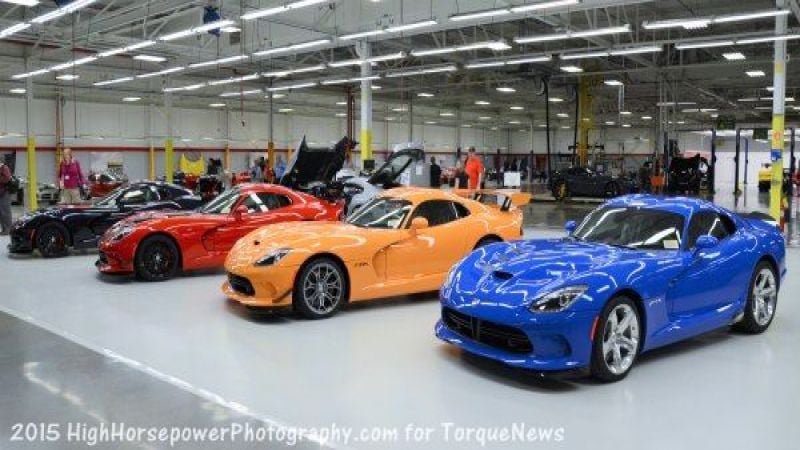We have discussed the future of the Dodge Viper a few times over the past month or so, and regardless of whether or not the monster supercar will come back years down the road, it seems that the Viper is within its final two years. The new contract between the Chrysler Group and the auto workers union states that the Viper will no longer be built at Connor Ave after 2017 and the contract doesn’t mention the Viper being built somewhere else – nor does it mention some other vehicle being built at Connor Ave. Typically, when an automaker tells the union that production will end at one plant, the company will explain where it will be built next and in this case, there is seemingly no future plan for the Viper.
So the Dodge Viper is about to go extinct – but why?
The short answer – and the reason why most vehicles leave an automaker’s lineup - is poor sales, but with the Viper, it is much deeper than just slow sales numbers.
Poor Sales Performance
While the Chrysler Group has never expected huge sales numbers from the Dodge Viper, the sales numbers this year and last year have been less than stellar. The company sold less than 800 units in 2014 and through the first 9 months of 2015, only 530 Vipers have been sold. Even as high price performance cars go, those numbers are fairly lackluster and while the company doesn’t expect huge sales numbers – huge sales numbers would have kept the Viper alive.
The poor sales performance comes from the fact that the Dodge Viper isn’t the overpowering monster that it once was. When the Viper was introduced in the early 90s, it was atop the performance car world and there had never been an American car that would do what the Viper would do and still be street legal. However, even with the steady progression of the Viper’s performance capabilities, the competition has closed the gap a great deal in the past few years.
For example, many magazine comparisons between the Chevrolet Corvette Stingray and the Dodge Viper have found the Corvette to be very close, if not quicker, and the Corvette is $30,000+ less expensive than the Viper. Back when the Viper was introduced, to get performance like the Viper offered, you had to buy a Viper. Today, you can buy a handful of cars that cost less and perform just as well as the Viper and that is the biggest factor in the Viper’s poor sales performance since returning to the lineup for 2013…but this isn’t just about sales.
Lost Branding Value
The Dodge Viper is and always has been more than just about sales volume. The Viper is one of those cars that most people will never own, but many will dream of owning. Enthusiasts young and old hang pictures of the Dodge Viper in their lockers or their garages; they have die cast collectables of the Dodge Viper and for those gamers, the Dodge Viper is always a hot commodity on any racing game. The Dodge Viper is a car that is idolized and dreamed about, but many of those people will never buy one.
At the same time, whenever people are buying Dodge Viper collectables or hanging up a poster or driving a Dodge Viper in a video game, they aren’t just driving a Viper – they are driving a Dodge. This positive association with the Dodge brand leads prospective buyers to favor that brand, so since the Viper was introduced back in the early 1990s, it has been a vehicle that got people talking about the Dodge brand. People would stop into Dodge dealerships just to see the Viper in person and while there, the salespeople had a chance to work their magic.
Even though the Dodge Viper has nothing to do with the Dodge Neon, a Dodge Ram or the Dodge Grand Caravan, the enthusiasm inspired by the Viper leads to sales of other, more acquirable vehicles. Unfortunately, while the Viper standing out less against the competition, it isn’t the idol that it once was and to make matters worse, Dodge has two cars with more power and better performance (in a straight line) than the Viper while costing substantially less.
Basically, the Viper is no longer the Dodge that many enthusiasts dream of owning, since the Hellcat-powered Challenger and Charger are both more powerful and more acquirable in terms of pricing. The Hellcat cars are among the most commonly searched vehicles online since they were announced back in 2014 and Hellcat fever has spread to ever corner of the car culture. The Hellcat Challenger and Charger have become the Dodge products that gets people into showrooms and best of all, the Hellcat cars are selling so well that the company cannot even keep up. The simple fact that the Hellcat cars “only cost” in the low $60k range whereas the Viper starts in the $80k range makes the Hellcat cars more attractive – but having 57 more horsepower and 50 more lb-ft of torque helps, too. The company doesn’t need a high priced supercar to get the Dodge brand name out there, as the Viper has been practically lost in the frenzy created by the Hellcat cars.
So, with the Dodge Viper posting poor sales numbers since its return and the decline in branding value, the Chrysler Group has really been left with no choice but to kill off the mighty Viper.
Fortunately, I still believe very strongly that in the next 5 years or so, we will see a return of the Dodge Viper – one which will once again have world-leading performance numbers to drive sales and brand interest. Unfortunately, it is likely going to be a few years before we get any official word on the next Dodge Viper.












Comments
Long live to Dodge Viper! I'm
Permalink
Long live to Dodge Viper! I'm a fan!
13 track records this writer
Permalink
13 track records this writer is full of horse hockey, Viper is the beast of performance open your eyes.
I have owned 4 Viper, & currently own 2. My latest is a new Gen v, this car by far is the most astonishing car I have ever owned. Style , performance ,cost, interiors you name it this is the best bang for the buck of any exotic hand built super car on the earth. Don't stop, do not wait one minute, any year viper will never be any cheaper than they are right now. Go , run , steel money from your piggy bank and buy one, any year just buy one before its too late. They will never be any cheaper. Your last chance to buy an American icon of witch we have not seen since Shelby Cobras sat on car lots and could not be given away. This is your chance to own a piece of history, to join others in the life of a Viper owner, join the Viper nation you will not regret the experience. Long live the iconic track king of all time, beware of the snake.
I agree with kom Peterson. I
Permalink
In reply to 13 track records this writer by kom peterson (not verified)
I agree with kom Peterson. I saw the same thing happen to the Hemi cars in the mid to late seventies. No one wanted them, used car lots couldn't give them away. Now they command huge money as collector cars. They will never be a better time to buy a Viper.
It would be sacrilege to some
Permalink
It would not be good to some, but they need to toss a blower on that 10! Be the first 1000hp American car! I know, I know, it's a track car, blah blah blah, who cares? With a blower you'd sell a lot more.
I believe the viper was
Permalink
I believe the viper was killed by auto journalist with their negative reviews
Guys open your eyes. If I
Permalink
Guys open your eyes. If I wanted to chose a super car I have many options. For the price of a dodge viper I could be rolling in a used (lightly used) porsche turbo S, a Z06, or plenty of other sports cars. The dodge viper is amazing but they are in the wrong cost band! Look at corvette! They have the right idea! Doesn't take a genius to realize why the corvette outsells the crap out of the viper. "Poor sales performance" isn't why the Viper is dying, it is dying because it doesn't give Americans the one thing we all want: Bang for the buck.